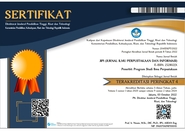Efektifitas Penggunaan EZPROXY Dalam Mengakses Jurnal Elektronik Bagi Mahasiswa Ilmu Perpustakaan Universitas Diponegoro
Abstract
This research was aimed to measure the effectiveness of using EZproxy on Single Sign On (SSO) in accessing electronic journals for Library Science students, Diponegoro University, Semarang. The analysis used a descriptive analysis method, which is a method that describes the data to get general conclusions. The sample was conducted by purposive sampling method. Collecting data was conducted by a questionnaire distributed to students as much 80 questionnaires. The results of this study are based on indicators of perceived ease of use resulting in a mean of 82.64% which is categorized as very effective; the perceived usefulness indicator produces the highest mean with a value of 83.80% which is categorized as very effective; behavioral intention to use indicator produces a mean of 79.89% which is categorized as effective; the actual system use indicator produces the lowest mean with a value of 74.7% which is categorized as effective. The results of the calculation of the mean value on all 35 statement items obtained a value of 81.25% which can be interpreted as very effective. So it can be concluded that EZproxy on Undip's E-Journal Single Sign On (SSO) service in accessing electronic journals has reached an effective level.
Keywords
Full Text:
PDFReferences
Abdullah, M. (2015). Metode Penelitian Kuantitatif (Cetakan 1). Aswaja Pressindo.
Davis, F. D. (1989). Perceived usefulness, perceived ease of use, and user acceptance of information technology. MIS Quarterly: Management Information Systems, 13(3), 319–339. https://doi.org/10.2307/249008
Ginting, M. Purwani, I. (2013). Kataloging e-Resources: Ekspansi pustakawan dalam mengolah bahan perpustakaan sumber elektronik. Media Pustakawan. Diakses dari https://www.perpusnas.go.id/magazine-detail.php?lang=en&id=8261
Harisyah. Azwar, M. (2014). Pemanfaatan Jurnal Elektronik oleh Mahasiswa Fakultas Kedokteran Universitas Hasanuddin Makkasar. Jurnal Ilmu Perpustakaan, Informasi Dan Kearsipan, Khizanah Al-Hikmah, 3(1), 79–88.
Jamaluddin. (2015). Mengenal Elektronik Jurnal Dan Manfaatnya Bagi Pengembangan Karir Pustakawan. Jurnal Elektronika, XIV(2), 38–44. Diakses dari http://journal.unhas.ac.id/index.php/jupiter/article/view/36/34
KBBI Online. (2020). Kamus Besar Bahasa Indonesia versi Onlie/Daring. Diakses dari https://kbbi.web.id/akses.
Lawrence, P. (2009). Access When and Where They Want It: Using EZproxy to Serve Our Remote Users. Computers in Libraries, 29(1).
Nurdin, I. Hartati, S. (2019). METODOLOGI PENELITIAN SOSIAL (Lutfiah (ed.)). Penerbit Media Sahabat Cendekia.
Panorama, Maya dan Muhajirin. (2017). Pendekatan Praktis Metode Penelitian Kualitatif dan Kuantitatif (Cetakan 1). Idea Press.
Singarimbun. Shofian, E. (1995). Metode Penelitian Survei. LP3ES.
Sugiyono, Noerdjanah dan Wahyu, A. (2020). Uji Validitas dan Reliabilitas Alat Ukur SG Posture Evaluation. Jurnal Keterapian Fisik, 5(1), 55–61.
Sugiyono. (2013). Metode Penelitian Pendidikan (Pendekatan Kuantitatif, Kualitatif dan R&D). ALFABETA.
Venkatesh, Viswanath dan Davis, F. D. (1996). A Model of the Antecedents of Perceived Ease of Use: Development and test. Decision Sciences, 27, 3, 451–481.
DOI: http://dx.doi.org/10.30829/jipi.v7i1.9742
Refbacks
- There are currently no refbacks.
Copyright (c) 2022 Stefi Melinda Saputri, Athanasia Octaviani Puspita Dewi

This work is licensed under a Creative Commons Attribution-ShareAlike 4.0 International License.










_1.png)
.png)
_.png)

